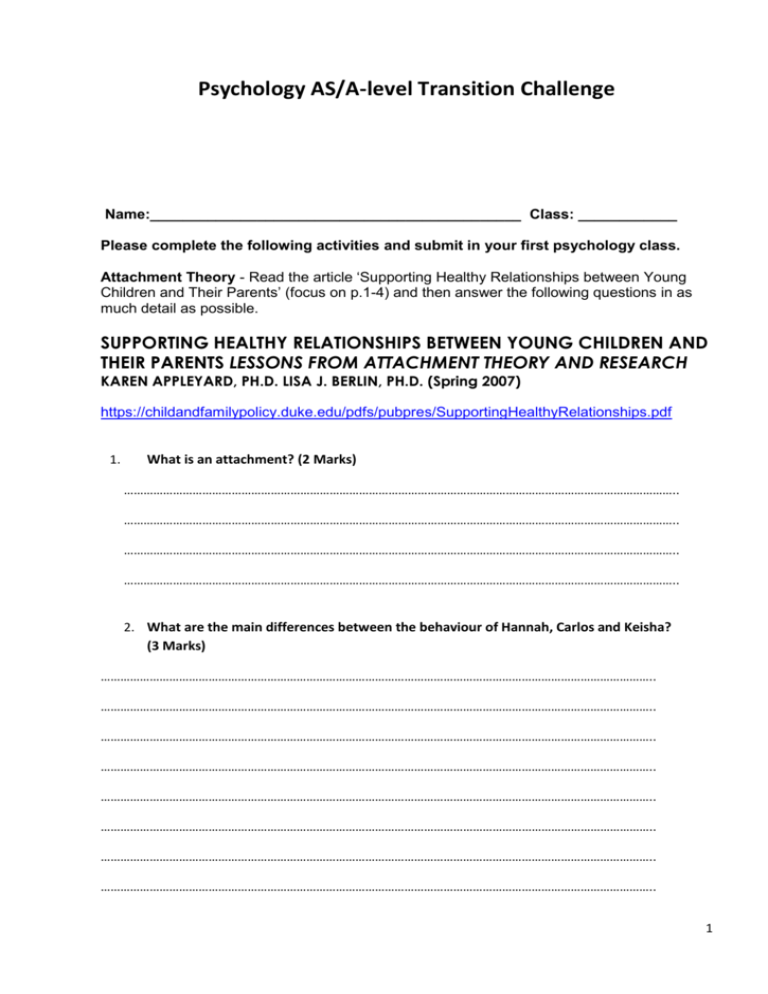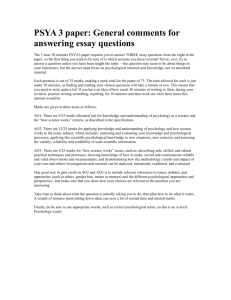PCA Psychology Transition task
advertisement

Psychology AS/A-level Transition Challenge Name:_____________________________________________ Class: ____________ Please complete the following activities and submit in your first psychology class. Attachment Theory - Read the article ‘Supporting Healthy Relationships between Young Children and Their Parents’ (focus on p.1-4) and then answer the following questions in as much detail as possible. SUPPORTING HEALTHY RELATIONSHIPS BETWEEN YOUNG CHILDREN AND THEIR PARENTS LESSONS FROM ATTACHMENT THEORY AND RESEARCH KAREN APPLEYARD, PH.D. LISA J. BERLIN, PH.D. (Spring 2007) https://childandfamilypolicy.duke.edu/pdfs/pubpres/SupportingHealthyRelationships.pdf 1. What is an attachment? (2 Marks) …………………………………………………………………………………………………………………………………………………….. …………………………………………………………………………………………………………………………………………………….. …………………………………………………………………………………………………………………………………………………….. …………………………………………………………………………………………………………………………………………………….. 2. What are the main differences between the behaviour of Hannah, Carlos and Keisha? (3 Marks) …………………………………………………………………………………………………………………………………………………….. …………………………………………………………………………………………………………………………………………………….. …………………………………………………………………………………………………………………………………………………….. …………………………………………………………………………………………………………………………………………………….. …………………………………………………………………………………………………………………………………………………….. …………………………………………………………………………………………………………………………………………………….. …………………………………………………………………………………………………………………………………………………….. …………………………………………………………………………………………………………………………………………………….. 1 3. What is the difference between an ‘attachment’ and ‘bonding’? (2 Marks) …………………………………………………………………………………………………………………………………………………….. …………………………………………………………………………………………………………………………………………………….. …………………………………………………………………………………………………………………………………………………….. …………………………………………………………………………………………………………………………………………………….. …………………………………………………………………………………………………………………………………………………….. …………………………………………………………………………………………………………………………………………………….. 4. What has research found promotes a secure attachment? (2 marks) …………………………………………………………………………………………………………………………………………………….. …………………………………………………………………………………………………………………………………………………….. …………………………………………………………………………………………………………………………………………………….. …………………………………………………………………………………………………………………………………………………….. …………………………………………………………………………………………………………………………………………………….. …………………………………………………………………………………………………………………………………………………….. 5. Briefly outline some of the characteristics (features) of each of these 3 attachment types: Describe the following types of attachment: (2+2+2+2 = 8 marks) a) Secure attachment – …………………………………………………………………………………………………………………………………………………….. …………………………………………………………………………………………………………………………………………………….. …………………………………………………………………………………………………………………………………………………….. Insecure attachment; b) Insecure Resistant – …………………………………………………………………………………………………………………………………………………….. …………………………………………………………………………………………………………………………………………………….. …………………………………………………………………………………………………………………………………………………….. c) Insecure Avoidant…………………………………………………………………………………………………………………………………………………….. …………………………………………………………………………………………………………………………………………………….. 2 …………………………………………………………………………………………………………………………………………………….. d) Disorganised – …………………………………………………………………………………………………………………………………………………….. …………………………………………………………………………………………………………………………………………………….. …………………………………………………………………………………………………………………………………………………….. 6. Which do you think is the optimal (best) attachment type to have and why? (1+3 marks) …………………………………………………………………………………………………………………………………………………….. …………………………………………………………………………………………………………………………………………………….. …………………………………………………………………………………………………………………………………………………….. …………………………………………………………………………………………………………………………………………………….. …………………………………………………………………………………………………………………………………………………….. …………………………………………………………………………………………………………………………………………………….. …………………………………………………………………………………………………………………………………………………….. …………………………………………………………………………………………………………………………………………………….. 7. Re-read the examples of the three children described in the article. Can you suggest which type of attachment classification they may have and why (6 marks) …………………………………………………………………………………………………………………………………………………….. …………………………………………………………………………………………………………………………………………………….. …………………………………………………………………………………………………………………………………………………….. …………………………………………………………………………………………………………………………………………………….. …………………………………………………………………………………………………………………………………………………….. …………………………………………………………………………………………………………………………………………………….. …………………………………………………………………………………………………………………………………………………….. …………………………………………………………………………………………………………………………………………………….. …………………………………………………………………………………………………………………………………………………….. 3 8. How might each of these attachment types affect you in later life – write a few sentences on each & say what the impact might be as you get older in terms of relationships with others: (no mark allocation) …………………………………………………………………………………………………………………………………………………….. …………………………………………………………………………………………………………………………………………………….. …………………………………………………………………………………………………………………………………………………….. …………………………………………………………………………………………………………………………………………………….. …………………………………………………………………………………………………………………………………………………….. …………………………………………………………………………………………………………………………………………………….. …………………………………………………………………………………………………………………………………………………….. …………………………………………………………………………………………………………………………………………………….. …………………………………………………………………………………………………………………………………………………….. …………………………………………………………………………………………………………………………………………………….. …………………………………………………………………………………………………………………………………………………….. …………………………………………………………………………………………………………………………………………………….. …………………………………………………………………………………………………………………………………………………….. …………………………………………………………………………………………………………………………………………………….. …………………………………………………………………………………………………………………………………………………….. …………………………………………………………………………………………………………………………………………………….. …………………………………………………………………………………………………………………………………………………….. …………………………………………………………………………………………………………………………………………………….. …………………………………………………………………………………………………………………………………………………….. …………………………………………………………………………………………………………………………………………………….. …………………………………………………………………………………………………………………………………………………….. …………………………………………………………………………………………………………………………………………………….. …………………………………………………………………………………………………………………………………………………….. …………………………………………………………………………………………………………………………………………………….. …………………………………………………………………………………………………………………………………………………….. 4 …………………………………………………………………………………………………………………………………………………….. …………………………………………………………………………………………………………………………………………………….. …………………………………………………………………………………………………………………………………………………….. …………………………………………………………………………………………………………………………………………………….. …………………………………………………………………………………………………………………………………………………….. …………………………………………………………………………………………………………………………………………………….. …………………………………………………………………………………………………………………………………………………….. …………………………………………………………………………………………………………………………………………………….. …………………………………………………………………………………………………………………………………………………….. …………………………………………………………………………………………………………………………………………………….. Studying Psychology involves analysing research and drawing conclusions from data. You need to go onto the internet to find out about a particular Psychology experiment. The research you need to find is the Ainsworth & Bell, 1970 (also referred to as Ainsworth et al, 1970) study into attachment types. You will be able to find a description of this study on the internet. 9. Outline what happened in the research and what they found. (6 marks) …………………………………………………………………………………………………………………………………………………….. …………………………………………………………………………………………………………………………………………………….. …………………………………………………………………………………………………………………………………………………….. …………………………………………………………………………………………………………………………………………………….. …………………………………………………………………………………………………………………………………………………….. …………………………………………………………………………………………………………………………………………………….. …………………………………………………………………………………………………………………………………………………….. …………………………………………………………………………………………………………………………………………………….. …………………………………………………………………………………………………………………………………………………….. …………………………………………………………………………………………………………………………………………………….. …………………………………………………………………………………………………………………………………………………….. …………………………………………………………………………………………………………………………………………………….. …………………………………………………………………………………………………………………………………………………….. …………………………………………………………………………………………………………………………………………………….. 5 …………………………………………………………………………………………………………………………………………………….. …………………………………………………………………………………………………………………………………………………….. …………………………………………………………………………………………………………………………………………………….. …………………………………………………………………………………………………………………………………………………….. …………………………………………………………………………………………………………………………………………………….. …………………………………………………………………………………………………………………………………………………….. …………………………………………………………………………………………………………………………………………………….. …………………………………………………………………………………………………………………………………………………….. …………………………………………………………………………………………………………………………………………………….. …………………………………………………………………………………………………………………………………………………….. …………………………………………………………………………………………………………………………………………………….. …………………………………………………………………………………………………………………………………………………….. …………………………………………………………………………………………………………………………………………………….. …………………………………………………………………………………………………………………………………………………….. …………………………………………………………………………………………………………………………………………………….. …………………………………………………………………………………………………………………………………………………….. 6 10. Use the graph paper below to display the findings from Ainsworth’s study using the ‘strange situation’. Provide a suitable title and fully label your graph. (3 Marks) Title: ................................................................................................................................... 11. On the course you will also have to know about different types of research methods. Find out what research method Ainsworth used in the strange situation and explain why it was that particular method. (3 Marks) Research Method: _______________________________ …………………………………………………………………………………………………………………………………………………….. …………………………………………………………………………………………………………………………………………………….. …………………………………………………………………………………………………………………………………………………….. …………………………………………………………………………………………………………………………………………………….. …………………………………………………………………………………………………………………………………………………….. …………………………………………………………………………………………………………………………………………………….. 7 12. A large part of the course and assessment focus on evaluating theories and research studies. Use the internet and textbooks to find strengths and weaknesses with Ainsworth’s theory of attachment types and/or research study using the Strange Situation. (6 marks) …………………………………………………………………………………………………………………………………………………….. …………………………………………………………………………………………………………………………………………………….. …………………………………………………………………………………………………………………………………………………….. …………………………………………………………………………………………………………………………………………………….. …………………………………………………………………………………………………………………………………………………….. …………………………………………………………………………………………………………………………………………………….. …………………………………………………………………………………………………………………………………………………….. …………………………………………………………………………………………………………………………………………………….. …………………………………………………………………………………………………………………………………………………….. …………………………………………………………………………………………………………………………………………………….. …………………………………………………………………………………………………………………………………………………….. …………………………………………………………………………………………………………………………………………………….. …………………………………………………………………………………………………………………………………………………….. …………………………………………………………………………………………………………………………………………………….. …………………………………………………………………………………………………………………………………………………….. …………………………………………………………………………………………………………………………………………………….. …………………………………………………………………………………………………………………………………………………….. …………………………………………………………………………………………………………………………………………………….. …………………………………………………………………………………………………………………………………………………….. …………………………………………………………………………………………………………………………………………………….. …………………………………………………………………………………………………………………………………………………….. …………………………………………………………………………………………………………………………………………………….. …………………………………………………………………………………………………………………………………………………….. …………………………………………………………………………………………………………………………………………………….. 8 You will study many different topics in Psychology on the course and one of them is memory. You will then study the reliability of eyewitness testimony. You will need to develop skills in analysing research and drawing conclusions from data. You need to go onto the internet to find out about a particular Psychology experiment. The research you need to find is the Loftus and Palmer (1974) study on leading questions and eyewitness testimony. You will be able to find a description of this study on the internet. 1. Outline what happened in the research and what they found. (6 marks) …………………………………………………………………………………………………………………………………………………………………………….. …………………………………………………………………………………………………………………………………………………………………………….. …………………………………………………………………………………………………………………………………………………………………………….. …………………………………………………………………………………………………………………………………………………………………………….. …………………………………………………………………………………………………………………………………………………………………………….. …………………………………………………………………………………………………………………………………………………………………………….. …………………………………………………………………………………………………………………………………………………………………………….. …………………………………………………………………………………………………………………………………………………………………………….. …………………………………………………………………………………………………………………………………………………………………………….. …………………………………………………………………………………………………………………………………………………………………………….. …………………………………………………………………………………………………………………………………………………………………………….. …………………………………………………………………………………………………………………………………………………………………………….. …………………………………………………………………………………………………………………………………………………………………………….. …………………………………………………………………………………………………………………………………………………………………………….. …………………………………………………………………………………………………………………………………………………………………………….. …………………………………………………………………………………………………………………………………………………………………………….. …………………………………………………………………………………………………………………………………………………………………………….. …………………………………………………………………………………………………………………………………………………………………………….. …………………………………………………………………………………………………………………………………………………………………………….. …………………………………………………………………………………………………………………………………………………………………………….. …………………………………………………………………………………………………………………………………………………………………………….. …………………………………………………………………………………………………………………………………………………………………………….. …………………………………………………………………………………………………………………………………………………………………………….. 9 …………………………………………………………………………………………………………………………………………………………………………….. …………………………………………………………………………………………………………………………………………………………………………….. ……………………………………………………………………………………………………………………………………………………………………………. 2. What do you think they were trying to find out by doing this research? (2 Marks) …………………………………………………………………………………………………………………………………………………………………………….. …………………………………………………………………………………………………………………………………………………………………………….. …………………………………………………………………………………………………………………………………………………………………………….. …………………………………………………………………………………………………………………………………………………………………………….. …………………………………………………………………………………………………………………………………………………………………………….. ……………………………………………………………………………………………………………………………………………………………………………. 3. Why do you think they conducted this experiment in a laboratory? (2 Marks) …………………………………………………………………………………………………………………………………………………………………………….. …………………………………………………………………………………………………………………………………………………………………………….. …………………………………………………………………………………………………………………………………………………………………………….. …………………………………………………………………………………………………………………………………………………………………………….. …………………………………………………………………………………………………………………………………………………………………………….. ……………………………………………………………………………………………………………………………………………………………………………. …………………………………………………………………………………………………………………………………………………………………………….. ……………………………………………………………………………………………………………………………………………………………………………. 4. What do you think are the problems with studying people’s behaviour in a set-up situation like a laboratory? (2 Marks) …………………………………………………………………………………………………………………………………………………………………………….. …………………………………………………………………………………………………………………………………………………………………………….. …………………………………………………………………………………………………………………………………………………………………………….. …………………………………………………………………………………………………………………………………………………………………………….. …………………………………………………………………………………………………………………………………………………………………………….. ……………………………………………………………………………………………………………………………………………………………………………. 10 5. Ecological validity means that a study is representative of real life. Do you think this study has ecological validity and why/why not? (2 Marks) …………………………………………………………………………………………………………………………………………………………………………….. …………………………………………………………………………………………………………………………………………………………………………….. …………………………………………………………………………………………………………………………………………………………………………….. …………………………………………………………………………………………………………………………………………………………………………….. …………………………………………………………………………………………………………………………………………………………………………….. ……………………………………………………………………………………………………………………………………………………………………………. 6. Demand characteristics occur when research participants are aware that they are taking part in a study, and change their behaviour. Do you think this study would have suffered from demand characteristics? Why/why not? (3 Marks) …………………………………………………………………………………………………………………………………………………………………………….. …………………………………………………………………………………………………………………………………………………………………………….. …………………………………………………………………………………………………………………………………………………………………………….. …………………………………………………………………………………………………………………………………………………………………………….. …………………………………………………………………………………………………………………………………………………………………………….. ……………………………………………………………………………………………………………………………………………………………………………. Glossary of terms Eyewitness testimony - how accurate we are at remembering events we have just seen. Laboratory experiment - where a situation is set up under controlled conditions to see how people behave in certain situations. Leading questions – when a question seems to suggest what the correct answer might be. 11 Final task: Essay question on the Strange Situation An important part of assessment in Psychology A-level exams is to answer 12 mark essays. There will be 6 marks available to ‘outline’ – It is assessed as Ao1 (assessment objective 1) and will assess your knowledge and understanding. There will also be 6 marks available to ‘evaluate’ – it is assessed as Ao3 and is your ability to analyse, interpret and evaluate. The grid below indicates how you will be assessed on these questions. Level 12-mark Description Evaluation Organisation Specialist question terminology 4 10-12 Accurate & wellThorough and Clear and coherent Used effectively detailed effective 3 9-12 Evident although Mostly effective Mostly clear and Mostly used occasional inaccuracies organised effectively 2 5-8 Mostly descriptive and Limited Lacks clarity & Used lacking accuracy in effectiveness organisation in inappropriately places places on occasions 1 1-4 Limited and many Limited, poorly Poorly organised Either absent or inaccuracies focused or used absent inappropriately 0 No relevant content You should now try to answer the 12 mark essay below with the material you have worked on. Outline and evaluate research into individual differences in attachment. (12 Marks) Advice: Think of each mark as one credit worthy point/paragraph you make. Please handwrite it on lined A4 paper with margins. This question should focus on Ainsworth’s (1970) study. Remember that only 6 marks are available for outlining the study. The findings and the conclusion are the most important parts. Don’t spend too long on describing how they conducted the study (i.e. the procedure). When you evaluate the study, remember to explain why something is strength or a weakness and what it means for the study. The question states research, so you can bring in more than one study. You should aim to make your essay around 1.5-2 sides of A4. You can take out a loan from the 6thform LAIC of the book: Psychology AS for AQA by Cardwell & Meldrum to assist you further with the tasks. Optional Extension Activity: Undertake further research on differences in attachment. Try to identify more research studies and see how you can make them fit into your essay. When you use multiple studies your essay, try to compare them and say what each study brings to the theory. I.e. what do they add or reject in the theory. You add complexity and evaluation by addressing how each study support, reject or add to the theory! 12 Optional Extension Activity 2: Research in your textbook ‘Cultural variations in attachment’ and attempt this question: Outline and evaluate research into Cultural variations in attachment (12 marks) 13






